
Nail art has seen some advances in the past decades, from the invention of cellulose-based polish 100 years ago, through thin plastic false nails, to the available-everywhere acrylic sculpted nails. But it was about time nails went techno.
On the security conference circuit, Baybe Doll (aka Emily Mitchell) had been getting her nail technician to embed small devices with readable data into her acrylic nails. However, the technology wasn’t available to the masses, and when it was, it was big and chunky.
NFC (near-field communication) tags are the solution; they’re tiny and they’re powered by nearby magnetic fields so they don’t need batteries. The first NFC tag I tried to put on my nail was an NXP Mifare Ultralight C NTAG213 that I bought from a supplier to retail stores (it’s the thing that makes your shopping go beep when you leave if it hasn’t been deactivated). It was huge in comparison to the ones I use now.
I started searching online for tiny NFC data tags and LED lights, and tried out a variety before settling on the NXP Mifare Classic 1K, which is only 9mm across and can store a surprising amount of data.
The main problem was how to protect the tags and LEDs from handwashing and showers whilst on your nails. Painting over them works — but it’s bumpy. Having them embedded in a sculpted nail by a nail technician is costly. This DIY method is a cheap and workable solution and, if you’re careful, can be reused.












